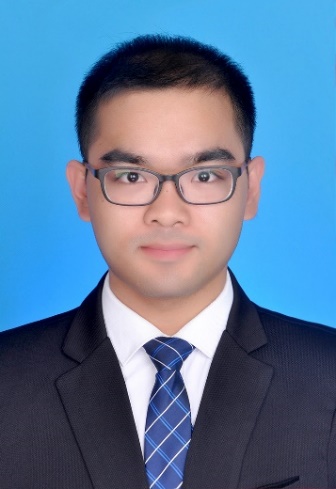博文
云师大物电学院卿晨副教授课题组在top期刊《Rare Metals》发表最新研究成果
||
 2024年8月21日,Springer旗下top期刊《Rare Metals》在线发表了云南师范大物理与电子信息学院卿晨副教授与郑州大学材料科学与工程学院国家低碳环保材料智能设计国际联合研究中心郭峻岭教授和武汉理工大学化学化工与生命科学学院材料复合新技术国家重点实验室刘金平教授合作的最新研究成果《Fe doping 1T phase MoS2 with enhanced zinc-ion storage ability and durability for high-performance aqueous zinc-ion batteries》。云南师范大物理与电子信息学院为第一作者单位,云南师范大物理与电子信息学院卿晨副教授与郑州大学材料科学与工程学院国家低碳环保材料智能设计国际联合研究中心郭峻岭教授和武汉理工大学化学化工与生命科学学院材料复合新技术国家重点实验室刘金平教授为共同通讯作者。
2024年8月21日,Springer旗下top期刊《Rare Metals》在线发表了云南师范大物理与电子信息学院卿晨副教授与郑州大学材料科学与工程学院国家低碳环保材料智能设计国际联合研究中心郭峻岭教授和武汉理工大学化学化工与生命科学学院材料复合新技术国家重点实验室刘金平教授合作的最新研究成果《Fe doping 1T phase MoS2 with enhanced zinc-ion storage ability and durability for high-performance aqueous zinc-ion batteries》。云南师范大物理与电子信息学院为第一作者单位,云南师范大物理与电子信息学院卿晨副教授与郑州大学材料科学与工程学院国家低碳环保材料智能设计国际联合研究中心郭峻岭教授和武汉理工大学化学化工与生命科学学院材料复合新技术国家重点实验室刘金平教授为共同通讯作者。
https://link.springer.com/article/10.1007/s12598-024-02963-8
Abstract
As a promising cathode material for aqueous zinc-ion batteries, 1T-MoS2 has been extensively investigated because of its facile two-dimensional ion-diffusion channels and high electrical conductivity. However, the limited number of available Zn storage sites, i.e., limited capacity, hinders its application because the inserted Zn2+, which form strong electrostatic interactions with 1T-MoS2, preventing subsequent Zn2+ insertion. Currently, the approach of enlarging the interlayer distance to reduce electrostatic interactions has been commonly used to enhance the capacity and reduce Zn2+ migration barriers. However, an enlarged interlayer spacing can weaken the van der Waals force between 1T-MoS2 monolayers, easily disrupting the structural stability. Herein, to address this issue, an effective strategy based on Fe doping is proposed for 1T-MoS2 (Fe-1T-MoS2). The theoretical calculations reveal that Fe doping can simultaneously moderate the rate of decrease in the adsorption energy after gradually increasing the number of stored atoms, and enhance the electron delocalization on metal-O bonds. Therefore, the experiment results show that Fe doping can simultaneously activate more Zn storage sites, thus enhancing the capacity, and stabilize the structural stability for improved cycling performance. Consequently, Fe-1T-MoS2 exhibits a larger capacity (189 mAh·g−1 at 0.1 A·g−1) and superior cycling stability (78% capacity retention after 400 cycles at 2 A·g−1) than pure 1T-MoS2. This work may open up a new avenue for constructing high-performance MoS2-based cathodes.(
摘要
由于具备二维离子扩散通道和高电导率, 1T-MoS2作为水系锌(Zn) 离子电池正极材料受到了广泛的关注和研究。然而, 已嵌入的Zn离子 (Zn2+) 会与1T-MoS2形成强的静电相互作用, 阻碍Zn2+的后续嵌入, 使可用的储Zn位点减少, 导致其实际比容量偏低。目前, 增大1T-MoS2的层间距以减小嵌入Zn2+与其的静电相互作用是最常用的提升比容量的策略。然而, 扩大层间距会降低层间的范德华力, 易导致1T-MoS2层状结构的崩塌, 降低其循环稳定性。因此, 在维持1T-MoS2循环稳定性的同时提升其比容量仍是一项挑战。本工作提出一种简单的铁(Fe) 掺杂策略, 用于保持1T-MoS2循环稳定性的同时提高其比容量。理论计算表明, 在逐渐增加储存原子数后, Fe的掺杂可以同时减缓吸附能的下降速度, 并增强金属-O键上的电子离域性。因此, 实验结果表明, Fe掺杂可以同时激活更多的储锌位点, 并同时加强其结构稳定性, 从而提高循环性能。Fe掺杂的1T-MoS2正极同时展示了高比容量 (0.1 A·g−1时为189 mAh·g−1) 和良好的循环稳定性 (2 A·g−1下400次循环的容量保持率为78%) 。这项工作为构建高性能MoS2的正极材料提供一条新思路。
)
 扩展阅读:
扩展阅读:
https://mp.weixin.qq.com/s/7Ggk8PYYY_fMHw47b8NsYg
卿晨,男,1990年3月出生,籍贯湖南永州,博士,凝聚态物理硕士生导师,云南省光电信息技术重点实验室成员。云南省兴滇英才计划青年项目及支持项目入选者(2019)。
一、教育经历:
2011.9-2017.7 华中师范大学 凝聚态物理 硕博连读
2007.9-2011.7 华中师范大学 物理学、数学 双学位
二、工作经历:
2020.11-至今 云南师范大学 物理与电子信息学院 副教授
2017.8-2020.10 云南师范大学 物理与电子信息学院 讲师
三、研究方向:
锂离子电池、超级电容器及水系锌离子电池正负材料的结构设计基础研究;
四、科研项目:
1、《氧空位型NiMoO4纳米棒的电子结构的第一性原理研究》:国家自然科学基金科学部综合管理项目, 2019.01-2020.20,主持;
2、《钴酸锰镍固溶体纳米片的可控制备及其水系中性电解液高压电容机理研究和非对称器超级电容器件的设计》,云南省兴滇英才支持计划青年人才配套支持项目,2019.06-2024.06,主持。
3、《氧缺陷型的钼酸镍多孔纳米片和线阵列结构可控制备及其电化学储能性能研究》:云南基础研究计划青年项目,2019.07-2022.06,主持;
五、学术成果:
1. Pengcheng Wang; Xinying Ding; Rongjie Zhe; Ting Zhu; Chen Qing*; Yingkai Liu; Hongen Wang*, Synchronous Defect and Interface Engineering of NiMoO4 Nanowire Arrays for High-Performance Supercapacitors, Nanomaterials, 2022, 12(7).
2. Yuanbin Wen, Pengcheng Wang, Xinying Ding, Xiaobo Feng and Chen Qing*, Roles of Oxygen Vacancies in NiMoO4: A First-Principles Study, Frontiers in Energy Research, 2021, 9(1): 1-5.
3. Tan, Qiuhong; Wang, Qianjin; Zhang, Chao; Gao, Kunpeng; Wang, Yuanfangzhou; Qing, Chen; Liu, Yingkai; Yu, Dapeng, Termination dependence and electric field modification of band alignment in a CNT/CH3NH3PbI3 heterojunction, Physical Chemistry Chemical Physics, 2021, 23(15): 9249-9258.
4. Chengxiang Yang; Chen Qing; Qianjin Wang; Xuejin Zhang; Jun Lou; Yingkai Liu, Synthesis of the hybrid CdS/Au flower-like nanomaterials and their SERS application, Sensors and Actuators B: Chemical , 2020, 304: 127218.
5. Wang, Qianjin; Tan, Qiuhong; Liu, Yingkai; Chen Qing; Feng, Xiaobo; Yu, Dapeng, Tunable Electronic Properties and Giant Spontaneous Polarization in Graphene/Monolayer GeS van der Waals Heterostructure, Physica Status Solidi B-Basic Solid State Physics, 2019, 256(11): 1900194.
6. Chen Qing; Yang, Chengxiang; Chen, Mingyue; Li, Wenhui; Wang, Shiyu; Tang, Yiwen, Design of oxygen-deficient NiMoO4 nanoflake and nanorod arrays with enhanced supercapaci-tive performance, Chemical Engineering Journal, 2018, 354: 182-190.
7. Chen Qing; Zhou, Qin; Qu, Gan; Chen, Xinqi; Wang, Hai; Sun, Daming; Wang, Bixiao; Xu, Lifeng; Tang, Yiwen, Designing 3D interconnected continuous nanoporous Co/CoO core-shell nanostructure electrodes for a high-performance pseudocapacitor, Nanotechnology, 2017, 28(8): 085401.
8. Chen Qing; Liu, Yanan; Sun, Xiaodan; OuYang, Xiaxia; Wang, Hai; Sun, Daming; Wang, Bixiao; Zhou, Qin; Xu, Lifeng; Tang, Yiwen, Controlled growth of NiMoO4·H2O nanoflake and nanowire arrays on Ni foam for superior performance of asymmetric supercapacitors, RSC Advances, 2016, 6(72): 67785-67793.
9. Chen Qing; Heng, Bojun; Wang, Hai; Sun, Daming; Wang, Bixiao; Sun, Miao; Guan, Shunli; Fu, Ranyan; Tang, Yiwen, Controlled facile synthesis of hierarchical CuO@MnO2 core-shell nanosheet arrays for high-performance lithium-ion battery, Journal of Alloys and Compounds, 2015, 641: 80-86.
六、联系方式:
chenqing@ynnu.edu.cn或qingchen1@126.com
https://blog.sciencenet.cn/blog-454141-1448138.html
上一篇:云师大化工学院胡蓉教授和杨通副教授在top期刊《Chemical Science》发表最新研究成果
下一篇:云南师范大学杰出校友之胡志丁教授
1 杨正瓴
该博文允许注册用户评论 请点击登录 评论 (0 个评论)

-
闂備焦鎮堕崕鎶藉磻濞戔懞鍥晸閿燂拷
|
 闂佽崵濮嶅鍡楊伓
+1
[17]dialectic
闂佽崵濮嶅鍡楊伓
+1
[17]dialectic
- 闂備礁鎼ˇ顖涱殽閹间礁鍌ㄦ繛鎴欏灪閸嬨劑鏌i弮鍥ㄧ【闁伙附绮撻幃鐑藉即濮橆厾銈板銈庡亜濞差參骞冨▎鎾村剬闁告縿鍎抽ˇ顕€姊洪棃鈺呮婵犮垺锚闇夋慨妞诲亾鐎殿喕鍗抽、娑樷枎閹烘垵绠戦梻浣规偠閸庢煡宕瑰┑鍠把勫緞閹邦厼鍓梺鍛婃处閸撴瑩鎮橀崶顒佺厸閻庯綆鍋嗛悳鑽ょ磼鏉堛劎绠炵€规洖鐖奸幃鈺傛綇椤愩値妲归梺鑽ゅ枑椤ㄥ棛鈧瑳鍥ц摕闁绘梻鍘ч幑鍫曟煏婵炵偓娅呭ù婊勭箞閺屾盯骞樺畷鍥嗐垽鏌熼绛嬫疁鐎规洘鐟╅幃鈺呭垂椤愵偂娣俊銈囧Х閸嬬喓鎹㈠┑鍫笉闁挎繂顦粈鍐煕濞戝崬鏋ゆ慨濠囩畺閺岋繝宕煎┑鎰ョ紓浣规煥閻°劎绮欐径鎰垫晜闁告洦鍓欑€b偓闂備焦鎮堕崕鎶藉磻閹剧鑰垮〒姘e亾闁哄苯娲弫鎰板礋椤栨碍鐤傞梻渚€娼婚梽鍕熆濡ソ鐟邦潨閳ь剟骞嗛崘顔肩妞ゆ劑鍨洪弳銉╂煟鎼粹剝璐℃繛鍛灮濡叉劕鈹戠€n亞顦╅梺绯曞墲閻熴垽鍩€椤掍季鎴﹀箚閺冨牊鏅滈悹鎭掑妿濡插繘鎮楅悷鏉款棌闁哥姵绋撻幑銏犫枎閹邦噮娲搁梺绯曞墲閸斿繘宕戦幘璇茬<婵﹩鍓欓崬銊╂煟鎼达絾鏆╂い銏狅躬閸┾偓妞ゆ巻鍋撻柟鍐叉唉閵囨劘顦撮柟鑼閹峰懘鎸婃径濠傜闂備胶鎳撻悘姘跺磿閹惰棄鏄ョ€光偓閸愶缚姹楅梺瑙勫劤閻°劑藝瑜旈弻娑樷枎韫囥儲顣兼繛瀛樼矋鐢€崇暦濠婂喚鍚嬮柛顐g☉娴犻箖姊洪崫鍕偓濠氥€佹繝鍥у惞婵犲﹤鍠氶崯鍛存煕濡ゅ啫浠﹂柛濠囦憾閺屸€愁吋閸涱厽些闂佸摜鍋涢顓㈠焵椤掑倹鍤€婵犫偓閸楃偐鏋旈柟杈剧畱閹瑰爼鏌℃径瀣嚋缂佸倸鐗撻幃妯跨疀濮樿泛鎽靛┑鈥冲级閹倸顕i崹顐㈢窞濠电姴鍋嗗ḿ婵嬫⒑濮瑰洤濡奸悗姘煎墮椤曪綁鎳為妷锝勭泊缂備焦绋戝﹢杈╃矆婢舵劖鐓曟繛鍡樏悘鈩冧繆閸欏鍊愮€规洜鍏樻俊鎼佸Ψ閿旇棄鏋﹂梻鍌欑劍瑜板啴鎯屾径灞绢潟闁汇垹鎲¢弲顒勬煥閻曞倹瀚�
濠电偛顕慨浼村磿鏉堚晝绀婇悗锝庡枛缁秹鏌涢幘鑼妽闁伙綀浜槐鎺撳緞鐎n亞浠告繝纰樺閸ャ劌浜归柣鐘叉惈閹碱偊寮稿畝鍕叆婵炴垶枪椤箓鏌嶈閸撴瑩鏁冮妶澶婄煑闊洦绋戦悙濠偳庨崶銊ヮ暢闁稿鎸鹃埀顒婄秵閸撴氨绮婇懠顒佸枑闁绘鐗婄亸顐ょ磼閵娿垹澧茬紒瀣槸椤撳ジ宕奸悢鐑芥7濠电偛鐡ㄧ划灞轿涚€靛憡顫曢柟鐑橆殕閺咁剟鏌ㄩ悤鍌涘
闂備胶鍘ч崲鏌ュ储閺嶎偉濮虫い鎺戝€圭€氭碍绻涢敐搴″幋闁稿鎸荤换婵嬪磼濮橆兛绱熼梻浣规偠閸庝即宕熷鈧崺鈧い鎺嗗亾妞ゆ垵娲ら埢鎾诲箣閻樼數锛滈梺绯曞墲閼规崘鐏愰梻浣告啞閸ㄧ敻骞栭锕€鐭楅柛鈩冪⊕閺咁剟鎮橀悙璺盒撻柛濠囦憾閹嘲螖娴e壊鍤嬮梺鍝勭灱閸犳牕鐣烽妷褌娌柣鎰靛墮閻掔ǹ鈹戦鍡欑ɑ闁哄被鍔戦妴鍛邦槼闁瑰嘲鎳樺鎾敂閸℃鍎梻浣筋嚃閸撴瑧鑺遍懖鈺冧笉闁绘劕鐡ㄦ禍銈嗙箾閸℃鎹i柡鍕€搁湁婵犲﹤妫欓妴鍐磼濡も偓椤︾敻鐛幘璇茬疀妞ゆ牗锚娴犻箖姊洪崫鍕偓濠氬箠閹捐绠栭柟鎹愵嚙鐎氬鏌i弬鎸庡暈缂佺虎鍨堕弻娑㈠籍閸屾銉︺亜椤掆偓濞层劑骞忛锕€纭€闁绘劗鏁哥粻鎺撶節绾版ǚ鍋撻崘娴嬪亾閹间礁绠栭柟鍓х節缁诲棝鏌涢弴銊ュ闁告ɑ甯¢弻锝夊Ω閵夈儺浠炬繝鈷€鍐ら柟濂夊亰楠炴﹢顢涘Δ鈧禍鐐節婵犲倸鏆為柛鏇㈢畺閺屾盯濡烽埡鍌涙闂侀€炲苯澧紒璇插閳绘捇骞嬮敃鈧崡鎶芥煛婢跺鐏熷ù婊愮悼閳ь剛鏁告晶妤呫€冮崼銉⑩偓鏍炊閳哄倸顏╅柡澶婄墐閺呮粓鎮鹃柆宥嗏拻闁稿被鍊曞▍宥嗐亜閿濆嫮鐭欑€规洏鍔戦敐鐐侯敊閹勫劒闂備礁鍚嬪姗€鎯屾笟鈧俊鍫曞锤濡も偓濡﹢鏌i悢鍝勵暭闁稿﹪浜堕弻锟犲醇閵忕姵鐏堥梺绋款儏閹冲繒绮嬪鍛婵☆垵顕х€b偓闂備焦鎮堕崕鏌ュ磿閹惰棄绠熼柛褎顨嗛弲顒勬倶閻愯泛浜归柣鐔哥箞瀵爼鍩℃担瑙勬倷婵犳鍨伴幖顐︻敋閿濆鎯為柛锔诲幗濮e牓姊洪悙钘夊姕缂侇喖鑻敃銏ゅ箻椤旇偐鍊為梻浣诡儥閸亪宕戦幘鏂ユ斀闁糕剝鍔曟禒娲⒑閸涘﹦娈扮€广儱娲ら幆鐐烘⒑閹稿海銆掗柛锝忓濡叉劙骞掑Δ浣规珫闂佽法鍣﹂幏锟�
闂佽崵濮村ú锕€岣垮▎鎾虫槬鐎光偓閳ь剛妲愰幒妤€骞㈡慨姗嗗劦濠靛鐓曢柟瀛樼箖閹牓鏌涘▎蹇旑棦闁轰礁绉舵禒锕傛嚃閳哄啯鍠掗梺鑽ゅ枑濞叉垵霉閸ヮ剦鏁嬮柍鍝勬噹閸欏﹥銇勯弽銊ㄥ缂傚秵鏌ㄩ湁闁绘瑥鎳愰崚鐗堢節閳ь剟骞橀鑲╁€為梺璇″瀻鐏炶棄韦闂備焦瀵х粙鎴︽嚐椤栨凹娼╅柕濞炬櫅閸欏﹥銇勯弽銊ㄥ缂傚秵鏌ㄩ湁婵犲﹤鍟幆鍫㈢磼闊彃鐏€垫澘瀚~婵嬪Ψ閵忕姳澹曟繝鐢靛С閼冲爼鎮烽埡鍛拻闁糕剝顨嗛ˉ鎾绘煃瑜滈崜娆擃敄閸愵喖鐒垫い鎴e劵閸忓矂鏌i悤浣风敖闁瑰嘲顑夐幊婊堫敄閽樺澹曟繛杈剧秬椤鎷归敓鐘冲仯濞达絽鍢插畵鍡涙煕韫囨棑鑰跨€规洘鐟╁畷顐﹀礋椤愩垺杈堥梻浣圭湽閸ㄦ椽鎳濇ィ鍏洭宕稿Δ浣规珫閻庡厜鍋撻柛鎰剁到娴滈箖鎮橀悙闈涗壕闁诲寒鍣i幃妤€鈽夐幎鑺ヮ€嶉梺鍝勵儏閸熶即鍩€椤掍胶鈯曟い銊ョ墕閳绘捇骞嬮悙缈犳唉闂佸綊鍋婇崰妤呭汲韫囨梹鍙忛柨婵嗘閳锋劗绱掓担鍓插殶缂佽鲸甯掕灒闁绘垶锚鐎b偓闂備焦鎮堕崕鎶藉磻閹炬緞锝夊箹娴e摜顓洪梺褰掑亰閸犳牠寮抽崘顭戠唵闁煎摜鏁搁悡顖滅磼椤帞绡€闁哄苯鐗撻獮瀣箳閺冨倹鍠掗梻浣呵圭换鎰矙閸曨厽顫曟繝闈涱儐閻掍粙鏌ㄥ┑鍡楊伀闁汇倕瀚伴弻娑樷枎瀹ュ應鍋撻幘璇茶埞妞ゆ帒瀚幑鍫曟煛婢跺顕滅紒鍌氱墦閺岋繝宕煎┑鎰ㄧ紓渚囧枛缁绘﹢骞婇悙鍝勭<婵﹩鍓氶惁鏃堟⒑缁嬭法绠為柛搴ゅ吹濡叉劕鈻庨幒瀣╂睏闂佽宕樺▔娑欐叏瑜嶉埥澶愬箻瀹曞泦銉╂煕韫囨枏鎴濐嚗閸曨垼鏁傞柛鈾€鏅濋埀顒佺叀閹湱鈧綆鍘剧花鍧楁煕閵堝繘妾紒鍌氱У閹棃濮€閿涘嫮鏆㈤梻浣告啞濮婄粯鎱ㄩ幘顔兼槬闁告洦鍘鹃惌澶愮叓閸ャ劍灏柛銈庡墮闇夋繝濠傚婢规﹢鏌涢埡浣虹劯鐎规洜濮磋灃濞达綀銆€閸嬫捇顢楅崟顐e祶闂佸壊鍋侀崹娲偩闁秵鐓欑痪鐗埫禍楣冩煟閻樺樊鍎愰柟閫涚窔婵″爼宕稿Δ鈧Λ姗€鏌i悢鍝勵暭闁告洟绠栭弻娑㈠Ψ閳哄啰鏆梺绋款儏閹虫ê顕f禒瀣闁靛牆娲ㄩˇ顐g箾閹寸偞灏紒澶愭涧鍗辩紒瀣儥閸ゆ鏌涢锝囩畵閻犱焦鐓¢弻锝夋倷閸欏妫ラ悶姘懇閺岋綁濡搁妷銉患闂佽鍟崶銊︽珫闂佽法鍣﹂幏锟�

-
闂備焦鎮堕崕鎶藉磻濞戔懞鍥晸閿燂拷
|
 闂佽崵濮嶅鍡楊伓
+1
[16]dialectic
闂佽崵濮嶅鍡楊伓
+1
[16]dialectic
-

闂備礁鎼悧婊堝礈濮橆兗缂氶柣銏⑶圭憴锔戒繆閵堝拋鍎戠紒鈧径鎰厸闁告洟娼ч悘锔姐亜鎼存ê浜鹃梺璇插缁嬫帡宕濋弽顬綁宕ㄦ繛澶哥泊濡炪倖甯掗崐鎼佀夐幒妤佺厱闁瑰濮撮崝瀣箾婵傚憡娑ч柍鐟板暙楗即宕熼鐘虫櫒闂備礁缍婂ḿ褏绮旈棃娴筹綁宕ㄦ繝鍕闂佸吋浜介崕鍐测攦閸曨垱鐓ユ繛鎴炨缚閻掗绱撻崼婊冨祮鐎规洜鍏樻俊鎼佸Ω閵夈儱顥楅梻浣告啞閼圭偓顨ラ幖浣告瀬闁跨喓濮撮懜鍦喐鎼搭煈鏁嗛柨婵嗘媼濞肩増銇勮箛鎾搭棤闁哄棭鍓欓湁闁绘﹩鍋勬禍鐐箾閹寸偞鐓ラ柣妤€绻掗弫顔济洪鍕杸闂婎偄娲﹂幐鍛婃叏娴犲鐓忛柛鈽嗗幗鐎氾拷

-
闂備焦鎮堕崕鎶藉磻濞戔懞鍥晸閿燂拷
|
 闂佽崵濮嶅鍡楊伓
+1
[15]pppoe201
闂佽崵濮嶅鍡楊伓
+1
[15]pppoe201
- 闂備胶枪缁绘劕螞濠婂嫮鐝堕柛銉墮缁€鍌炴煕椤愮姴鐏柡鍛倐閹鈽夊畷鍥╂殺闂佹眹鍊ら崰妤冪矙婢舵劦鏁囬幒鎶藉磻椤忓牊鐓ユ繛鎴炃圭€氭壆鎲搁悧鍫㈢煂缂侇喗鐟╅崺鈧い鎺嶈兌閳绘洟鎮楅敐搴濈盎閻庯絺鍋撻柣搴㈩問閸犳帡宕戦幘璇茬骇闁割偁鍨归弸鏃堟煟閺嶎剚顏犵紒顔藉哺閹虫粓宕归銈呭笌濠碘槅鍋呭妯何涘Δ鍛亗婵炲棙鎸婚弲顒勬倶閻愯埖顥夌€电増鎹囬弻鐔衡偓娑櫭慨鍫ユ煟韫囨搩妲搁柣锝嗙箞瀹曟帒鈽夊▍鐚寸畱閳藉骞欓崘褏鐩庨梺绯曟櫅濡盯骞夌€涙ɑ濯撮柣锝呮湰椤岸姊哄ú璇插季闁告ḿ鏅划濠囶敆閸曨剙娈岄梺鍛婄⊕濠㈡﹢宕㈤幘顔界厱婵ê澧介悾閬嶆煟閿濆鐣洪柟顖氬暣瀹曠喖鍩為幆褌澹曢梺璺ㄥ櫐閹凤拷


-
闂備焦鎮堕崕鎶藉磻濞戔懞鍥晸閿燂拷
|
 闂佽崵濮嶅鍡楊伓
+1
[14]wqhwqh333
闂佽崵濮嶅鍡楊伓
+1
[14]wqhwqh333
- 闂備礁鎲¢敋婵☆偅顨夐妵鎰板醇閺囩喎鍓洪梺鍝勫暙閸婄敻寮埀顒勬煙閻撳海鎽犳俊顐$窔椤㈡艾顫濈捄鍝勭彉婵犮垼娉涢ˇ閬嶎敂闁秵鐓曢柟鐑樺灦椤ワ繝鏌i敃鈧ˇ鐢哥嵁閹达富鏁婃繛鍡樺劤濞堫垱绻涢幋鐐村皑闁稿鎹囬弻娑㈠箳閹寸儐妫ラ梺浼欑細缁瑩寮鍥︽勃闁兼祴鏅濋幉瑙勭節閵忕姴顣抽弸顏堟煏閸パ勫缂佸顦濂稿炊閳哄啰顦梺璇茬箰缁绘劗鎹㈤崼銉ョ劦妞ゆ巻鍋撻柛濠勬嚀宀e潡寮撮姀鈥冲壄闂佸憡娲﹂崢楣冨春閿涘嫮纾肩€光偓閸愨晝銆愰梺瀹︽澘濮傜€规洜鍏樻俊鎼佸Ψ瑜嶈ぐ鍌涚節閵忥絽鐓愭慨妯稿姂瀵悂骞掑Δ浣叉嫽濡炪倖娲栧Λ娑氱矆婢跺ň妲堥柟缁㈠灠娴滅偓绻涚€涙ḿ鐭嬬紒瀣笒鍗遍柟杈剧畱閸欏﹪鏌熺憴鍕缂佺姳绮欓弻銈夊礃閹绘帩娈紓浣靛妸閸斿酣鍩€椤掆偓濠€閬嶅磻閹达箑鐒垫い鎺戯攻鐎氾拷

-
闂備焦鎮堕崕鎶藉磻濞戔懞鍥晸閿燂拷
|
 闂佽崵濮嶅鍡楊伓
+1
[13]闂備礁鎼ˇ顖涱殽閹间礁鍌ㄦ俊銈呮噺閸ゅ矂鏌ㄩ悤鍌涘
闂佽崵濮嶅鍡楊伓
+1
[13]闂備礁鎼ˇ顖涱殽閹间礁鍌ㄦ俊銈呮噺閸ゅ矂鏌ㄩ悤鍌涘
- 闂備浇顫夋竟鍡涘窗閺囥垺鈷撻柛褎顨嗛崑婵嬫倵閿濆簼绨婚悽顖滃仱閺屾稑饪伴崘顓烆伃濡炪倧闄勭€笛囧箯閸涱収鍚嬮柛銉㈡櫇鏁堥梻浣告啞閻熴儵顢栭崶褉鏋旈柟瀵稿仧闂勫嫰鏌ら幁鎺戝姎濠㈢懓鐗撻弻锟犲焵椤掑嫷鏁嶆繛鎴炨缚濡茬兘姊洪棃娑欙紨闁瑰嚖鎷�

-
闂備焦鎮堕崕鎶藉磻濞戔懞鍥晸閿燂拷
|
 闂佽崵濮嶅鍡楊伓
+1
[12]chenhuansheng
闂佽崵濮嶅鍡楊伓
+1
[12]chenhuansheng
- 闂備胶鎳撻悺銊╁垂婵傞潻缍栭幖绮规閸ゆ淇婇妶鍛灓婵炶偐濞€閹鈽夐崘宸喘缂傚倸绉撮ˇ閬嶅焵椤掑倹鏆╅柟铏尵濞嗐垽鎮㈤悡搴i獓闁硅偐琛ラ埀顒€鍟垮ù顕€姊洪懝閭﹀殐闁搞劋鍗冲畷銏犫槈閵忊€充缓闂佺粯姊婚崕銈夋偩闁秵鍋℃繛鍡楃箰閳ь剙顭峰畷鎴︽晲婢跺娅栭柣蹇曞仧閺咁偊宕i幋锔藉€垫鐐茬仢閻忚鲸銇勯銏″枠鐎规洦鍨辩换婵婄疀閺囩媴绱�
闂佸搫顦悧鍐疾閻愪警鏁婇柟杈剧畱閻鎮橀悙闈涗壕闁绘挻鐟╅弻锝夊Ω閵夈儺浠圭紓浣广仠閸ㄥ骞夐弻銉ラ敜婵°倐鍋撻柛妯绘尦閺屾稖绠涢敐鍛潻缂備浇椴搁崹鍨暦閿濆绠i柨婵嗗暊閸嬫捇宕橀埡鍐炬锤闂佺硶妲呴崢鍓х矆婢跺绠鹃悘鐐登规晶鍙夌節閳ь剚鎷呴崷顓ф祫闂侀€炲苯澧紒瀣躬瀹曠厧鈹戦崨顖氬⒕闂佽崵鍋炵喊宥囨暜閹烘鐤鹃柨鐕傛嫹

-
闂備焦鎮堕崕鎶藉磻濞戔懞鍥晸閿燂拷
|
 闂佽崵濮嶅鍡楊伓
+1
[11]safe110
闂佽崵濮嶅鍡楊伓
+1
[11]safe110
- [10]junkscience 2017-7-20 12:36
[8]safe110 2017-7-20 11:36 闂備線娼荤拹鐔煎礉鐏炵煫鐟拔旈崨顔规寖闂佸憡渚楅崜娑氱玻濡ゅ懏鍋e〒姘搐閺嬫瑧绱掑Δ鈧崐缁樼濮濆瞼鐤€闁哄洨濮烽悡渚€姊虹涵鍛牚闁稿酣浜堕獮澶愭晸閻樿櫕娅栭柣蹇曞仧閸嬫挾绮婚幒鎳ㄥ綊鎮╅顫濠电偞鍨堕弻銊╂偋韫囨稑鐓濋柛顐ゅ枔闂勫嫰鏌涢妷鎴濆閺嬶箓姊洪幐搴b槈闁兼椿鍨伴敃銏ゎ敂閸℃瑧鐓嬮梺鐟扮摠缁诲秹宕濋崨顖滅=闁告劏鏅涢悡鈧紓浣瑰敾閹凤拷
=============
闂備線娼荤拹鐔煎礉鎼搭煉缍栭柡宥庡亐閸嬫挸鈽夐崘宸喘缂傚倸绉撮ˇ鎵矙婢跺绡€闁稿本姘ㄥ畝娑欑箾閹寸偞灏ㄩ柛瀣尵缁辨帡鍨鹃搹顐㈩槱闂佹眹鍎遍幊妯虹暦椤栫偛唯闁挎棁妫勯惁璇参旈悩闈涗粶缁剧虎鍘奸埢鎾诲箣閿曗偓绾偓濠殿喗锕╅崢浠嬫倵椤曗偓瀵爼鍩¢崑鍐茬秺閵嗗懘鏁冮埀顒勵敋閵夈儙鏃€鎷呯粙娆炬婵犵數鍋炶ぐ鍐敄閸℃瑥顥氶梺顒€绉甸弲顒勬煥閻曞倹瀚� 闂佸搫顦弲婊堟晪闂侀潧鐗呯划娆撶嵁閸ヮ亞鐤€闁哄倸鎼禍鐐節闂堟稈鐪嬮柛銈嗙洴閺屾盯骞掑┑鍡曠暗濠殿喚鎳撻ˇ鍨繆閹绢喗鏅搁柨鐕傛嫹 闂備礁鎼悧鍡浰囬幎钘夌婵せ鍋撻柟铏崌楠炲洭宕滄担渚Х 闂備礁鎲$敮妤€顭垮Ο濂界懓螖閸涱喒鎸冮梺鍛婁緱閸撴稓绮eΔ鍛仯濞撴艾娲ら弸娆戠磼濡も偓閸婂灝鐣烽姀銏″珰闁圭粯甯炲畝娑㈡煟閻愬鈼ら柛鏂款儑缁晝鈧數枪婵剟鏌涢妷鈺婃缂佲偓閿燂拷 闂備胶鎳撻悺銊╂偋閻愬搫鐒垫い鎺嗗亾闁瑰啿閰e畷鍝勭暆閸曨偆鍊為梺鑺ッˇ顖炲极閸洘鐓熼柕濞垮劚椤忣亞绱掓担鍓插殶缂佽鲸甯掕灒缂備焦岣块崚浼存椤愩垺澶勬い銊ユ嚇閻涱噣骞樼拠鑼厬闂佺懓鐡ㄧ划搴敂鏉堚晝纾奸柍銉ㄦ珪缁侇偆绱掗幉瀣
闂備礁鎼悧婊堝礂濞戞褎寰勯幇顒傤吋閻庡箍鍎卞ú锕傛倵婵傚憡鍊垫繛鎴炲▕濡绢喚绱掓笟鍥у⒋闁轰礁绉舵禒锕傛嚃閳哄啯鍠掗梻浣规た閸樺綊宕曢幍顔剧鐎广儱妫涢埢鏂课旈敂绛嬪劌闁哥喎鐗撻弻锟犲磼濮橆厾銈紓浣介哺缁诲牆鐣烽垾鎰佹僵妞ゆ挾鍠撻埀顒夊枛閳藉寮崒姘€婚悷婊勫Ω閸パ冨挤濡炪倖鐗楃划宥囩不濞嗘挻鐓熸い蹇撳閸庡秹鏌嶈閸撱劑骞忛敓锟�
濠电偞鍨堕幐鍝ョ矓妞嬪孩宕查柛鎰靛枟閺咁剛鈧厜鍋撻柍褜鍓熼敐鐐哄冀椤愮喎浜炬繛鎴濆暱椤╊剛绱撳鍜佹█鐎规洍鈧剚娼╂い鎰╁灮濡诧絾绻涚€电ǹ袨闁稿骸宕锝夋倻閽樺顢呭┑顔斤供閸撴瑩宕欓悩缁樼厱婵炲棗绻愰埀顒€鎲¢幈銊╂倷閸濆嫮鍊炴繛瀵稿Т椤戝棝顢撴惔鈭跺綊宕楅梻缈犲濡炪倖鏌ㄩ幊姗€骞嗛崘顔肩妞ゆ巻鍋撻柛妯诲浮閺屸剝寰勯崼婵嗗缂備焦顨呴ˇ杈ㄧ閹间礁绠fい鏍ㄧ矌椤︻噣姊虹粙娆惧剱闁煎綊绠栨俊鐢稿炊閵娿儺鍤ゅ┑顔斤供閸樿壈顣块梻浣告啞缁嬫垿鏁冮敃鈧埢鎾诲箣閻愮鏋欓梺缁樻煥閹诧紕绮婚幒妤佺厱闁绘棃娼ぐ鎺戠劦妞ゆ帒锕ョ€氾拷
婵犵數鍋炲ḿ娆擃敄閸モ晛鍨濇い鏍ㄧ矌閻捇鏌熺€涙ḿ绠ラ柛鏃撴嫹 闂備礁鎼ˇ顖炲磹閸濄儲宕查柡鍐ㄧ墛閺咁剟鎮橀悙鎻掓倯濠碘姍鍐f闁哄倸娼¢妤佺節閳ь剟顢旈崼婵堝€為梺鑺ッˇ顖炲极閸撲胶纾奸柣妯煎仺娴狅妇绱掗妸銏℃珔闂囧霉閿濆牜娼愰柛鈺佸€块弻娑㈠箳閹存柨鎮嶇紓浣介哺缁诲牆鐣烽崼鏇熷亹閺夊牜鍋嗛ˇ浼存煛婢跺棙娅嗛拑杈ㄧ節閳ь剟鏁撻敓锟� 婵犵數鍋炲ḿ娆擃敄閸モ晛鍨濇い鏍ㄥ閸嬫挸鈽夐幎鑺ヮ€嶆繝娈垮櫙閹凤拷 闂備礁鎽滈崰搴㈢仚闂侀€炲苯澧柛濠佺矙椤㈡岸鎮剁粚鐒爇science 闂備礁鎲¢〃鍡涙嚌閹屽殨闁告縿鍎茬€氭岸鏌曡箛瀣偓鏍晬閺嵮€妲堥柟缁㈠灠娴滅偓绻涢幋鐐村碍妞ゆ垵娲ら湁濠㈣埖鍔曠粈鍌炴煕韫囨挻鍣洪柣顏冪矙閺屾稑鈽夊▍杈ㄧ矒閸┾偓妞ゆ帒锕ョ€氾拷

-
闂備焦鎮堕崕鎶藉磻濞戔懞鍥晸閿燂拷
|
 闂佽崵濮嶅鍡楊伓
+1
[10]junkscience
闂佽崵濮嶅鍡楊伓
+1
[10]junkscience
- [8]safe110 2017-7-20 11:36 闂備線娼荤拹鐔煎礉鐏炵煫鐟拔旈崨顔规寖闂佸憡渚楅崜娑氱玻濡ゅ懏鍋e〒姘搐閺嬫瑧绱掑Δ鈧崐缁樼濮濆瞼鐤€闁哄洨濮烽悡渚€姊虹涵鍛牚闁稿酣浜堕獮澶愭晸閻樿櫕娅栭柣蹇曞仧閸嬫挾绮婚幒鎳ㄥ綊鎮╅顫濠电偞鍨堕弻銊╂偋韫囨稑鐓濋柛顐ゅ枔闂勫嫰鏌涢妷鎴濆閺嬶箓姊洪幐搴b槈闁兼椿鍨伴敃銏ゎ敂閸℃瑧鐓嬮梺鐟扮摠缁诲秹宕濋崨顖滅=闁告劏鏅涢悡鈧紓浣瑰敾閹凤拷
=============
闂備線娼荤拹鐔煎礉鎼搭煉缍栭柡宥庡亐閸嬫挸鈽夐崘宸喘缂傚倸绉撮ˇ鎵矙婢跺绡€闁稿本姘ㄥ畝娑欑箾閹寸偞灏ㄩ柛瀣尵缁辨帡鍨鹃搹顐㈩槱闂佹眹鍎遍幊妯虹暦椤栫偛唯闁挎棁妫勯惁璇参旈悩闈涗粶缁剧虎鍘奸埢鎾诲箣閿曗偓绾偓濠殿喗锕╅崢浠嬫倵椤曗偓瀵爼鍩¢崑鍐茬秺閵嗗懘鏁冮埀顒勵敋閵夈儙鏃€鎷呯粙娆炬婵犵數鍋炶ぐ鍐敄閸℃瑥顥氶梺顒€绉甸弲顒勬煥閻曞倹瀚� 闂佸搫顦弲婊堟晪闂侀潧鐗呯划娆撶嵁閸ヮ亞鐤€闁哄倸鎼禍鐐節闂堟稈鐪嬮柛銈嗙洴閺屾盯骞掑┑鍡曠暗濠殿喚鎳撻ˇ鍨繆閹绢喗鏅搁柨鐕傛嫹 闂備礁鎼悧鍡浰囬幎钘夌婵せ鍋撻柟铏崌楠炲洭宕滄担渚Х 闂備礁鎲$敮妤€顭垮Ο濂界懓螖閸涱喒鎸冮梺鍛婁緱閸撴稓绮eΔ鍛仯濞撴艾娲ら弸娆戠磼濡も偓閸婂灝鐣烽姀銏″珰闁圭粯甯炲畝娑㈡煟閻愬鈼ら柛鏂款儑缁晝鈧數枪婵剟鏌涢妷鈺婃缂佲偓閿燂拷 闂備胶鎳撻悺銊╂偋閻愬搫鐒垫い鎺嗗亾闁瑰啿閰e畷鍝勭暆閸曨偆鍊為梺鑺ッˇ顖炲极閸洘鐓熼柕濞垮劚椤忣亞绱掓担鍓插殶缂佽鲸甯掕灒缂備焦岣块崚浼存椤愩垺澶勬い銊ユ嚇閻涱噣骞樼拠鑼厬闂佺懓鐡ㄧ划搴敂鏉堚晝纾奸柍銉ㄦ珪缁侇偆绱掗幉瀣

-
闂備焦鎮堕崕鎶藉磻濞戔懞鍥晸閿燂拷
|
 闂佽崵濮嶅鍡楊伓
+1
[9]闂備胶绮划宀勵敄閸涙潙桅闁搞儺鍓欑粈鍌炴煥閻曞倹瀚�
闂佽崵濮嶅鍡楊伓
+1
[9]闂備胶绮划宀勵敄閸涙潙桅闁搞儺鍓欑粈鍌炴煥閻曞倹瀚�
- 闂佽崵濮撮鍐垂婵傚憡鈷撶紒铏规晿fe110闂備焦鐪归崝宀€鈧凹鍓涚槐鎾诲箻閼搁潧顎涘銈嗘閵嗏偓闁稿鎹囬弫鎾绘晸閿燂拷 闂備胶鎳撻悺銊╁垂瑜版帒鐏虫俊顖氱毞閸嬫捇宕烽鐐版勃闂佹眹鍎遍幊妯侯嚕閸偄绶炲┑鐐层仒閸犲﹥绻濋姀锝呯厫婵ǜ鍔岄埢鎾诲箣閿曗偓閸屻劑鎮规担鍝ワ紞闁哥喎锕幃宄扳枎濞嗘垹蓱濠电偛鍚嬪ú鐔风暦濡ゅ懎骞㈡慨姗嗗墻濡洭姊洪崨濠勭煀闁兼椿鍨跺畷褰掝敆閸曨剙鈧攱绻濇繝鍌氼仾闁诲寒鍠氱槐鎺楀籍閸屾銉︾箾閸喎鐏╃紒杈ㄥ浮瀹曞崬顫濋鈺傜箞閺屻劌鈽夐搹顐㈩伓 闂備焦鎮堕崕铏叏瀹曞洦瀚婚柣鏃傚帶閹瑰爼鏌曟繝蹇曠暠闁诲繐顦埥澶愬箻鐎涙ê鐭紓浣诡殘閸犳劗绮欐繝鍕ㄥ亾閿濆簼鎲炬俊顖氭閺岋綁濡搁妷銉純濠碘槅鍋夐崺鏍晬閹邦儵鐔封枎閻愵剛鐓戦梻浣侯攰閸嬫劙宕戦悙鍝勯棷闁挎洖鍊归弲顒勬煥閻曞倹瀚� 闂傚倸鍊稿ú鐘诲磻閹剧粯鍋¢柡鍥ㄧ缁佹澘鈹戦鐓庢毐妞ゆ洏鍎靛畷鐓庘攽閹邦厸鏌ら梻浣告惈閸燁偊鎮ラ悡骞盯宕稿Δ浣稿壄闂佸憡娲嶉弬渚€宕戦幘缁樻櫢闁跨噦鎷� 闂備胶鎳撻悺銊╁垂閸洘鍎夐柛娑欐綑鐎氬顭跨捄鐚村伐鐟滅増妞介幃娲箳閻愮數袣婵犳鍠楁繛濠傤嚕椤曗偓瀹曞ジ寮撮悤鍌滃惞闂備線娼荤拹鐔煎礉韫囨洘宕查柡宥庡幖濡ḿ鎲搁悧鍫濈瑲婵℃ぜ鍔戦弻鏇㈠幢椤撶喎顏� 濠电偠鎻徊钘壩涘▎蹇ヨ€垮〒姘e亾妤犵偛顑夐獮瀣偐瀹曞洦娈搁梻浣告啞鐢鎹㈤崘顕呮晢闁绘劕鎼涵鈧梺鐟板槻閻線寮舵禒瀣叆婵炴垼娅曠€氾拷
1. 闂備礁鎼ˇ顖涱殽閹间礁鍌ㄦ俊銈呮噺閸ゅ本銇勯弽銊х煁闁伙綁浜堕幃宄扳枎韫囨挴鍋撴繝姘;闁挎繂顦崣濠冦亜閺嶎偄浠ч柣鎾达耿閺岋繝宕熼锝嗗闯濠电偛鐗婇崹鍧楀极瀹ュ鏅搁柨鐕傛嫹 闂備礁鎼悧鍡浰囬鐐叉辈闁归偊鍠楃€氭岸鏌℃径瀣仸婵炲牞缍侀弻鏇㈠幢椤撶喎顏� 闂備礁鎲$敮妤€鐜婚崸妤€纾瑰┑鐘崇閸庡秹鏌涢弴銊ユ珮婵炵厧閰i弻锝夊箛椤栵絾缍堝┑鈥冲级閹倸顫忔ィ鍐ㄧ疀妞ゆ挾鍠撹ぐ姘舵⒑濮瑰洤濡奸悗姘憸濡叉劙鏁撻敓锟� 濠电偞鍨堕幐鍝ョ矓閻戣棄纾绘俊銈呮噺閸庡酣鎮楀☉娅亝寰勫澶嬪仯闁搞儮鏅╁Λ搴€亜椤愩垺鍠橀柟顔界懇閹倿宕妷褜妲� 闂佽绻愮换妤併仈缁嬭锝夊箹娴e憡宓嶉梺闈涒康闂勫嫮绱炲澶嬬厽闁靛ǹ鍎遍鈺冣偓瑙勬磸閸庨潧顕i鍕倞闁挎洑绀侀獮鈧梻浣烘嚀閹诧繝宕归崼鏇熷剨婵炲樊浜濋崕澶愭煕濠婂啫鏆熺紒鈧敓锟� 闂備礁鍚嬪姗€寮甸鍌楀亾濞堝灝浜伴柟顖氬暣瀹曠喖顢楅崒娑掓瀺闂備焦鐪归崕閬嶅箠瀹ュ洨绠斿璺侯儑椤╃兘鏌涘☉鍗炲闁荤喐绻傞埥澶愬箻椤栨矮澹曢梺璇叉唉椤绌卞ú顏庣稏闁挎洖鍊哥粈鍐煕濞戙垹浜伴柡鈧禒瀣厽闁靛ǹ鍎遍褏绱掑Δ浣瑰暗闁逞屽墰椤㈠﹪宕洪弽顐f殰闁圭虎鍠栭惌妤佷繆閵堝拋鍎戠紒鈧敓锟� 闂佽绻愮换妤併仈缁嬭锝夊川婵犲啩姘﹀┑鐐叉閹哥ǹ鈻嶉敓鐘崇厽闁靛ǹ鍎遍鈺傘亜閿曚礁鍚归柟顔芥緲閻f繈宕熼銏犵濠电偞鍨堕幐鍝ョ矓閻戣棄绀傛慨妞诲亾妤犵偞甯℃俊鐑藉Ψ閵壯呅氶梻浣瑰閸愬骞忛敓锟� 濠电偞鎸婚懝楣冾敄閸涙番鈧懓顦虫い顏佸亾闂佸憡娲﹂崜姘辨偖閸楃偐妲堥柟鎯х-灏忕紓渚囧枤婵挳濡撮幒妤€围闁糕剝锚闂傤垶姊虹粙璺ㄧ疄闁稿孩鐓¢獮鎴︽晲婢跺鍓梺鍛婃处閸ㄩ亶鏁嶉弽顬盯鎮ч崺铏灴瀹曠懓饪伴崨顒傚墾闁哄鐗冮弲婊呯棯椤栫偞鐓欓柟顓熷笒閸旀氨鈧鍠涙慨銈夊Φ濞嗘垟鍋撻崷顓炐ョ紒鐘崇墵閺屻劌鈽夐搹顐㈩伓 闂備礁鎲$敮妤€鐜婚崸妤€纾归悹鍥ㄧゴ閺岋箓鏌嶉埡浣告殲缂佺姵甯掗埞鎴﹀磼濠婂嫭鐝┑鐐茬墛閸ㄥ綊骞夐幘顔芥櫜濠㈣泛锕ラ悵鐢告⒑閹稿骸鍠曢柟鍑ゆ嫹
2. 闂備礁鎼ˇ顖涱殽閹间礁鍌ㄦ俊銈呮噺閸ゅ本銇勯弽銊р姇婵炲牏鍠庨湁婵犲﹤鍟銏犫攽閳ヨ櫕鍟炵紒鍌涘浮瀵粙顢曢敐鍥ㄦ闂佽崵鍠愰悷銉╁磹婵犳艾纾婚柨婵嗩槸缁狀垶鏌涢…鎴濇灈闁绘挸鍊块弻娑㈠Ψ閵婏富妫勯梺鍝ュ仜閻°劌顕ラ崟顖氬唨妞ゆ帒鍊婚鎰箾閹寸偞鎯勫ù婊庝邯閵嗗倿顢曢敃鈧弰銉╂煟閺冨倸鍔嬮柣锝変憾閺岋繝宕煎顑垮濠德板€曢崐鍦箒缂備焦顨嗛幐楣冨焵椤掑倹鍤€闁绘牕銈稿畷鎴﹀川鐎涙ḿ鍘掗柣蹇曞仩濡嫮绮婚悽鍛娾拻闁告劏鏅涙慨宀勬煕椤愵偂閭柡浣哥Ч閺佹捇鏁撻敓锟� 濠电偞鍨堕幐鍝ョ矓閻㈢ǹ鐒垫い鎺嶇劍缁€鈧梺绯曟櫅濡瑧绮嬪澶嬫優閻熸瑥瀚弳鐘绘⒑閸涘﹦鎳冪紒澶婄秺閸╃偠绠涘☉娆愭珫闂佸壊鍋呯换鍕级娴犲鈷掗柛鏇ㄥ亝閸e摜绱掑Δ鈧崐鎼佸煝娴犲鐒洪柛鎰ㄦ櫇閻f娊姊绘担鐟扮祷缂佸鎸虫俊鐢稿炊椤掍礁鍓梺鍛婃处閸嬪嫰宕橀埀顒佷繆閻愬弶璐℃い鎺曞皺濡叉劕顫濋懜鍨珫閻庡厜鍋撻柛鎰剁到娴滈箖鎮橀悙鑸殿棄闁诲繑鐩弻锝夊箛椤撶姷鐒肩紓渚囧枤婵炩偓鐎殿喖鐖兼俊鐑藉Χ閸モ晜鍠掗梻浣芥〃闂勫秹宕归悜妯圭箚闁告稑锕﹂々鐑芥煛瀹擃喖鍟崬銊╂煟鎼存繄绁锋い顐㈩槸宀e潡寮撮姀鐘殿槯闂佺硶鍓濋懝楣兯夊畝鍕厽闁靛ǹ鍎遍顒併亜椤愩垺鍠橀柟顔界懅閹叉挳宕熼銈嗗暔闂備礁鎲$敮妤€顭垮Ο濂界懓螖閸涱厾顦ㄩ梺鍛婁緱閸欏骸螣閸℃稒鐓曟慨姗嗗墰閻掗攱銇勯姀鈥崇伌闁诡垰鍟村畷鐔碱敂閸℃瑦鍣伴梺璇叉捣閹虫捇鎮ユ總绋跨;闁告稑鐡ㄩ悡鍌炴倶閻愯埖顥夌紒鐘垫暬閺屻劌鈽夐搹顐㈩伓 闂備胶鎳撻悘姘仚闂佷紮闄勭换鍐矙婢跺鍋婇柛顭戝枟椤斿洭鎮楅崷顓€纭呫亹婢跺瞼绠斿鑸靛姇閻鏌熸潏鍓хシ闁逞屽墮閸熸潙顕i鍕倞闁冲搫鍟繛鍥⒑閹稿骸鍠曢柟鍑ゆ嫹 闂佽绻愮换妤併仈缁嬭锝夊传閵夛箑鐝伴柣鐘辩閸熸寧鎱ㄥ☉銏$叆婵炴垼娅曠€氾拷 闂備礁鎲¢崝鏍偡閵娾晩鏁嬮柣妤€鐗忛埢鏇㈡煥閺囨浜剧紓浣哄劋閸庢娊顢氶妷銉富閻忓繑鐗曟禍楣冩煕鐏炴崘澹橀柣蹇旂洴閺岋綁骞囬鐘电厐濠殿喗菧閸斿秴岣跨拠娴嬫瀻闁归偊鍠栭ˉ搴ㄦ⒑缁嬫鍎愭慨妯稿妼閳绘捇骞嬮敃鈧憴锕傚箹濞n剙鐏ù婊庡灦閹ǹ绠涘璺烘懙濠碘€冲级閹倸鐣烽悜钘壩╃憸婊冡缚閻樼粯鍊垫繛鎴濆暱椤╊剛绱撳鍜佹Ч缂佸顦扮换婵嬪礋椤撳嫬娲ㄩ埀顒侇問閸犳牜鈧凹浜炵划顓熷緞閹邦剛鐤囬梺绋挎湰缁秹鎮鹃柆宥嗙厱婵°倓鑳堕悡顖炴倵闂堟稓鐒搁柡浣哥Ч閺佹捇鏁撻敓锟� 闂佽崵濮甸崝鎴﹀磿閸楃偍缂氶柡宥庡幖缁狙囧箹缁厜鍋撻崘鍙夎癁闂備浇澹堥鏍垂閸愭祴鏋旈柟杈剧畱鐟欙妇鈧箍鍎遍幏鎴犳閿濆鐓ユ繛鎴f珪鐎氾拷 闂佽崵濮崇拋鏌ュ疾濞戙垹鏄ラ柛鈩冪⊕閸庡秹鏌涢弴銊ヤ簻閻熸瑱绠戦埥澶愬箻鐠団€虫濡ょ姷鍋為幑鍥ь嚕閻楀牊鍎熼柨婵嗗€甸崑鎾愁潨閳ь剙鐣烽敐鍜佸悑闁告粈绀佸▓鎼佹⒑閸濆嫷妲稿Δ鐘虫倐瀹曘垹螖閸涱喖娈炲銈嗙墦閸婃绮堥敓锟� 闂備礁鎲¢崹鐓庮浖閵娧嗗С闁跨喓濮甸悡銉︾箾閸℃ḿ鎳呯紒鈧敓锟� 闂備礁鎲$敮妤€鐜婚崸妤€纾归柤濮愬€撻悞濠囧级閸偄浜介柛銈嗙洴閺岀喓鈧稒锚閻忥箓鏌i妷銉﹀殗鐎殿喖鐏氬鍕償閿濆浂鍟囧┑鐐村灦閺屻劑鎮ч幇閭︽晪闁冲搫鍊规禍銈夋煥閻曞倹瀚�
3. 濠电偠鎻徊鎸庢叏妤e啯鍎嶉柕澶嗘櫅缁€鍡涙煙濞堝灝娅樻繛鑲╁█閹鈽夐崘宸喘缂傚倸绉撮ˇ杈╂閹捐鍐€妞ゆ帒鍊哥粩濂告⒒娓氬洤鏋旈柛鏂块閳绘捇骞嬮敂钘夊壋闁诲函缍嗛崑鍡涘Υ婵犲洦鐓ユ繛鎴f珪鐎氾拷 闂備胶鎳撻悺銊╁垂瀹曞洨绠斿鑸靛姈閸庢鏌曟径鍡樻珒濠㈣娲滅槐鎺撳緞鐎n亞浠村銈嗗笧閸犳挾妲愰弮鍫濈闁绘ê鐏氶妵婵嬫煛婢跺﹦澧涢柛銊ユ健瀹曟洟骞橀钘夊壄闂佸憡娲﹂崢鐣岀不濞嗘劗绠惧璺侯儐缁岃法绱掗幉瀣 濠电偠鎻徊钘壩涢弮鍌氬灊妞ゆ帊鑳堕々閿嬨亜閹烘垵鈧綊鎮鹃柆宥嗙厽妞ゅ繐瀚烽崕鎰棯椤撶偟鍩i柡浣哥Ч閺佹捇鏁撻敓锟� 濠电偞鍨堕幐鍝ョ矓闂堟党锝夊川婵犲啩姘﹀┑鐐叉闁帮綁宕电€n€盯寮堕幐搴闂佺粯鎸婚悷鈺侇嚕閸洖绀冮柕濞垮灪閻庤鲸绻涢幋鐐村鞍闁瑰憡鎮傞、娆忣吋婢跺鍓梺鍛婃处閸樼晫绮诲▎鎰濠㈣泛顑嗙壕鎼佹煃瑜滈崜銊╁箯閿燂拷
濠电偠鎻徊钘壩涘▎鎾冲瀭婵犲﹤瀚禍銈嗕繆椤栨粎甯涚粭鎴︽倵閸偅绶查柣妤€锕畷婵嬪川椤栨稑顏╁銈庡亽閸樺墽绮欓幋锔藉€靛ù锝呭枤濞兼劙鏌涢妸锔剧煉妤犵偞鎹囬獮鍥敊閻e本娈搁梻濠庡亜濞层劍鎱ㄩ幘顔肩疅闁跨喓濮磋繚闂佺ǹ鏈粙鎴︽倶婢舵劖鐓曢煫鍥ㄧ绾箖鏌i妶鍛伃鐎殿喕鍗抽、娑樷枎閹寸姵鍠掗梻浣告贡婢ф鈧瑳鍥х闁规鍠楀畷澶愭煟閺傚灝妲婚柣鎺斿帶闇夋繝濠傛閵嗗啰绱掗妸锝呪偓婵嗙暦閵夆晜鍋ㄩ柛顭戝亞閺嗙娀姊洪幐搴″枙闁瑰嚖鎷� 闂備礁鎲¢悷顖涚濠靛棴鑰垮〒姘e亾鐎规洜鍏樻俊鎼佹晜閸欘偓绠撻弻娑㈡晜閸濆嫬顬嬪┑鐘亾闁告侗鍠氶埢鏃傗偓骞垮劚鐎氼噣鎮烽幘缁樼厱婵☆垵鍋愮敮娑欎繆閻愭彃鈧潡寮澶嬫櫢闁跨噦鎷� 闂備礁缍婂ḿ褏绮斿畷鍥潟濞村吋娼欑粈鍕煟閹寸倖鎴︽⒔瀹ュ鍋i柛銉e妽缂嶆垿鏌涢妶鍡楃伌鐎规洩缍佹俊鐑芥晲閸屾矮澹曢梺璺ㄥ櫐閹凤拷
闂佽崵濮村ú鈺併€掗崷顓犵婵☆垳绮慨婊勩亜閹哄棗浜鹃梺纭咁嚋缁绘繂鐣峰顑╃喖鎮℃惔妯轰壕濠电姵纰嶉弲顒勬煥閻曞倹瀚� 濠电姷顣介埀顒€鍟块埀顒€缍婇幃妯诲緞鐎n剦娴勯梺鍝勭▉閸撴瑩宕㈤幘顔界厵閻犺櫣灏ㄥ妤冪磼椤曞懎澧撮柟顖氬暣瀹曠喖顢氶崨顔剧У闂備胶绮崝姗€锝炴径濞綁骞嬮悩鍐插幑濡炪倖姊婚崑鎾绘偩闁秵鐓曢柟閭﹀幘閹冲嫰鏌涢妸锔绢暡缂佸顦甸崺鈧い鎺戝€告慨顒勬煕閵夛絽濡介柣搴枤缁辨帡寮崒姣裤垺绻濋埀顒勵敂閸涱垪鏋栭梺瑙勫礃鐏忔瑩鎮疯ぐ鎺撶厸濠㈣泛锕ら埀顒€鎽滈幑銏ゅ籍閳ь剛绮欐径瀣瘈闁稿本姘ㄥ畝娑㈡煟閻愮繝绶遍柣鎾愁槺濡叉劙鏁撻敓锟� 闂備胶鎳撻悺銊╁垂瀹曞洨绠斿璺虹灱娑撳秹鏌嶉妷锕€澧柛銈囧█濮婃椽骞愭惔锝嗗櫏缂備焦顨呴惌鍌氱暦閵夆晜鏅滈柤娴嬫櫇椤︻噣姊洪悷鎵憼闁搞劑娼ч~婵嬪Ω瑜忕壕鍏肩節闂堟稒锛嶉柛銈囧Т閳藉骞樺畷鍥嗐垽鏌涢悢鎻掍壕闂佽崵濮村ú銊ф崲濠靛牏绠斿〒姘e亾闁哄苯妫濋獮姗€鎼归銈忕闯濠电偛鐡ㄧ划灞轿涚€靛憡顫曢柨鐕傛嫹 闂備焦鎮堕崕铏叏瀹曞洦瀚婚柣鏂垮悑閻掍粙鏌ㄥ┑鍡欏鐎规洘濞婇弻锝夘敊缂佹ḿ銈伴梺闈涙閸熸壆鍒掗崼鐔稿闁规鍠氶幊鍥ㄧ箾閹寸偞灏伴柣顓у枤缁參骞橀崹娑樹壕閻熸瑥瀚崝鑸点亜閹惧墎甯涚紒瀣樀瀹曨偊宕熼銈勭捕闂備胶绮崝鏍垝鎼粹檧鏋旈柟瀵稿У閸犲棝鏌涚仦鍓х煀濞寸媭鍨堕弻锟犲醇濠垫劖笑閻熸粎澧楅悡鈥崇暦閿濆鍐€闁挎梻铏庨崥鍛節閵忥絾纭鹃悗姘憸濡叉劕鈹戠€n亞鐓戝銈嗙墬閻熴倗鑺辨导瀛樼厱婵炲棙鍔曢悘閬嶆煏閸☆厽瀚� 濠电偠鎻徊鍓у垝閸垺瀚婚柣鏃囥€€閸嬫挸鈽夐幎鑺ヮ€嶅┑鐘亾闁惧浚鍋嗛々鎻掝熆鐠哄搫鐦ㄩ柛鐔风墦閺屾洟宕遍鐔奉伓

-
闂備焦鎮堕崕鎶藉磻濞戔懞鍥晸閿燂拷
|
 闂佽崵濮嶅鍡楊伓
+1
[8]safe110
闂佽崵濮嶅鍡楊伓
+1
[8]safe110
- 闂備線娼荤拹鐔煎礉鐏炵煫鐟拔旈崨顔规寖闂佸憡渚楅崜娑氱玻濡ゅ懏鍋e〒姘搐閺嬫瑧绱掑Δ鈧崐缁樼濮濆瞼鐤€闁哄洨濮烽悡渚€姊虹涵鍛牚闁稿酣浜堕獮澶愭晸閻樿櫕娅栭柣蹇曞仧閸嬫挾绮婚幒鎳ㄥ綊鎮╅顫濠电偞鍨堕弻銊╂偋韫囨稑鐓濋柛顐ゅ枔闂勫嫰鏌涢妷鎴濆閺嬶箓姊洪幐搴b槈闁兼椿鍨伴敃銏ゎ敂閸℃瑧鐓嬮梺鐟扮摠缁诲秹宕濋崨顖滅=闁告劏鏅涢悡鈧紓浣瑰敾閹凤拷
闂備礁鎼ˇ顖涱殽閹间礁鍌ㄦ繛鎴欏灪閸嬨劑鏌i弬鎸庢喐婵﹪绠栭弻锟犲醇濠垫劖啸缂備緡鍠楅悷褏妲愰幒鎴悑闁告侗鍘鹃崝鑸电箾鐎涙ḿ鐭庢繛鍜冪到閳绘捇骞嬮敃鈧粻鐢告煙閹殿喖顣奸柨娑欑墵閺屾盯骞囬浣告濡炪倖姊归崝娆忕暦閵夘煈妾紓浣稿船閻忔氨绮欐径鎰ч柛鏇ㄥ幘瀛濋梻浣搞偢椤o妇绮堟笟鈧畷銏犫槈閵忊€充缓闂佺粯鏌ㄦ晶搴ㄦ偡濠靛鍋℃繛鍡楁禋濡插摜绱掗幆浼村摵缂佽桨绮欏畷鍫曞Ω閵忕姳澹曞銈呯箰閸婄敻宕戦幘缁樻櫢闁跨噦鎷�

-
闂備焦鎮堕崕鎶藉磻濞戔懞鍥晸閿燂拷
|
 闂佽崵濮嶅鍡楊伓
+1
[7]safe110
闂佽崵濮嶅鍡楊伓
+1
[7]safe110
- 闂備礁鎼ˇ顖涱殽閹间礁鍌ㄦ繛鎴欏灪閸嬨劑鏌i弮鍌氬妺闁伙綁浜堕弻锟犲磼濮橆厼绐涢梺缁樼箓閸㈡煡顢欒箛娑欏殤妞ゆ帒鍊诲鍓х磽娴gǹ鈧粙顢氳濡叉劙骞嬮悜鍥╃>闂佸搫绋侀崢褰掑焵椤掆偓椤︾敻寮鍥︽勃濠殿喗鍔曟禒娲⒑缁嬭法孝缂佺粯鍨块幆鈧柛娑欐綑鐎氬顭跨捄鐑樻崳缂佺姴顭烽弻娑滅疀鐎n亜濮嶇紓浣诡殔閹虫ê螞閸愵喖顫呴柕蹇ョ磿閺嗙娀姊洪崨濠傜瑨婵☆偅绋撻幃顕€顢曢敃鈧崘鈧棅顐㈡处濞叉ḿ绮eΔ鍛厪闁糕槅鍘界€氾拷
闂備胶鎳撻悺銊╁垂婵傞潻缍栭幖绮规閸ゆ淇婇妶鍜佸剳缂佲偓婢跺ň妲堥柟鎯х摠鐏忣厽銇勯弬璺ㄐg紒瀣槸椤撳ジ宕奸銏″€犻梻浣告啞閻燁垶宕归婊冨灊妞ゆ帒瀚崕宥夋煕閺囥劌骞樻繛澶堝灲閹鎷呴崫鍕濠碘€冲级閹倸鐣峰Δ鍛闁兼亽鍎插▓顖炴⒑閹稿海鈽夊┑鍌涙⒒缁厼鐣濋埀顒傚垝閺冨牆绠f繝鍨姇婵″磭绱撻崒姘殲闁搞劌婀卞Σ鎰邦敂閸涱喚绉堕梺鐟邦嚟閸嬬偤鏁撻妷鈺傜厱闊洦娲栨禒娲煃瑜滈崜銊╁箯閿燂拷
婵犳鍠楃缓鍧楀磹閺団懞鍥ㄧ節濮橆厽娅栭悗鍏夊亾闁告劦浜為鏇㈡⒑闂堚晠妾繝銏∶湁婵☆垵宕甸埢鏂库攽閻樺弶鍣界紒鐘劜缁绘稓浠﹂挊澶婄缂備焦顨呴張顒勨€旈埀顒勬煕閺囥劌澧悶姘朵憾濮婃椽顢欓挊澶屼喊缂備焦顨呴ˇ鐢稿箠濡ゅ懏瀵犲璺猴躬濞堫剟姊洪崨濠備刊闁稿鎸惧Σ鎰攽鐎n亝宓嶉梺闈浨归崕鍝勎熺€n€㈢懓饪伴崨顓炲闁诲骸鐏氬畝绋跨暦濞嗘劖濮滈柟娈垮櫘閸氬懘姊洪崨濠呭婵﹫濡囬幑銏ゅ即閻旇 鏋栭悗骞垮劚閻楀棝宕㈢€靛摜妫い鎾楀啯鐏曞銈嗘尭椤兘寮鍥︽勃闁兼祴鏅濋弳顐︽⒑閻撳骸妲婚柛鐔诲劵閵囨劙宕掗悙鍙夘棟闂佹悶鍎滈崟鎴旀櫊閹鎷呯化鏇炰壕闁绘洑绀侀幃顏堟煟閻樿京绐旂紓鍌涘哺閸┾偓妞ゆ巻鍋撻柟閿嬪灩濡叉劕鈹戦崼婊呭墾闁哄鐗滈崑鎺楀吹濞戙垺鐓曢柕蹇ョ到閽勫吋銇勯弮鈧Λ鍐ㄧ暦閵夘煈妲归梺閫炲苯澧鹃柟鍑ゆ嫹
濠电姰鍨奸崺鏍儗椤斿墽涓嶉柣鎰暩娑撳秹鏌嶈閸撶喎鐣烽敓鐘插嵆闁绘ê纾弳鐘崇箾鐎涙ḿ鐭婃い鎴濇瀹曟洝绠涘☉妯兼焾婵犵數鍋涚花閬嶅磻閹捐纾兼慨姗嗗墲椤斿姊虹拠鈥崇仭缂侇喖鐭傚鏌ュ煛閸涱厙銉╂煥閻曞倹瀚�
闂備浇顕栭崰鎾诲礉韫囨侗鏁嬮柍鍝勫€婚々鐑芥煛瀹ュ骸澧柛妯绘尦閺岋綁顢欓懞銉㈡嫽闂佸疇顫夌敮鈥崇暦閿濆围闁告侗鍠栫€b偓闂備焦鎮堕崕鏌ュ磿閹惰棄绠栫憸鏃堝极瀹ュ鍋勯柣鎾崇凹缁ㄥ吋绻涢幋鐐存儎濞存粠浜獮妤呭箛閺夎法楠囨繝銏f硾閹芥粓鎯佸鍡欑閻忕偟枪婢у弶绻濋埀顒佺瑹閳ь剙鐣峰▎鎾冲耿婵炲棗澶囬崑鎾澄熸總钘夋贡閳ь剨缍嗛崢鎯i幖浣圭叆婵炴垶锚椤ㄦ瑧绱掑Δ浣哄缂佸顦濂稿醇椤愩垺顔嗛梻浣告啞閻楁鎮ч弴銏╂晢闁绘梻鍘х粻锝夋煙闁缚绨婚柡浣圭矒閺屾洟宕卞Δ鈧埀顒佹倐閹儵宕滄担鐟扮彴闂佺硶鍓濋〃鍡椻枍閹剧粯鐓忛柛鈽嗗幗鐎氾拷
濠电偞鍨堕幐鍫曞磹閹惧墎绀婇柛娑樼摠閸も偓婵炶揪绲挎灙閻㈩垬鍎甸弻锝夊閵忕姵鐏嗗銈庡亜妤犳悂顢氶妷銉庢梹鎷呴崫銉ョ稇闂佽崵鍠愰悷銈囩矆娴e浜归柡灞诲劜閸ゅ嫰鏌ら幁鎺戝姎闁诲繐娲ㄧ槐鎺楀棘濞嗘儳鍓梺閫炲苯澧鹃柟鍑ゆ嫹

-
闂備焦鎮堕崕鎶藉磻濞戔懞鍥晸閿燂拷
|
 闂佽崵濮嶅鍡楊伓
+1
[6]濠殿喗甯楃粙鎴犫偓姘煎墴閹箖濡搁埡鍐ㄧウ闂佽法鍣﹂幏锟�
闂佽崵濮嶅鍡楊伓
+1
[6]濠殿喗甯楃粙鎴犫偓姘煎墴閹箖濡搁埡鍐ㄧウ闂佽法鍣﹂幏锟�
- 闂佽崵濮村ú銊╁蓟婢舵劧缍栭柨鐕傛嫹http://blog.sciencenet.cn/blog-415-1067229.html
濠电偞鍨堕幐鍝ョ矓閸洦鏁囬柛婵勫劤閻捇鏌熺€涙ḿ绠ラ柛鏂挎噽缁辨捇宕橀埡浣轰患缂備線纭告禍婵嗎缚韫囨稑绠i柨鏇楀亾闁告柣鍎甸弻锟犲礋闂堟稓浠╅梺璇″灟缁舵艾鐣烽妷褌娌柟顖嗗喚妫堥梻浣告惈椤︻垱顨ラ幖浣稿偍婵°倕鎳忛崵灞俱亜閺嶃劏澹橀悽顖樺劦閺岋綁濮€閵忕姵鐏佸┑鐐茬墛閸ㄥ潡鐛崶顏嗙杸閹兼番鍩勯崑銊╂⒑閹稿海鈽夐柣顓濊兌閹广垽寮介鐐插敤婵$偛顑呯€涒晠鎮鹃柆宥嗙厱婵°倓鑳堕。鏌ユ煛鐎n亜鏆炵紒瀣槸椤撳ジ宕卞Δ鍕倕闂備浇澹堟慨銈夊礉瑜忓Σ鎰攽閸モ斁鏋栭悗骞垮劚濞层劎绱欓柆宥嗏拺妞ゆ劑鍩勫褏绱掓潏銊х畼闁逞屽墮濠€閬嶅磻濞戞﹫鑰挎い蹇撴鐎氭氨绱撻崼銏犘ラ柣鐔哥箞瀵爼鍩℃担瑙勬倷濡ょ姷鍋為幑鍥ㄤ繆閹绢喗鏅搁柨鐕傛嫹



-
闂備焦鎮堕崕鎶藉磻濞戔懞鍥晸閿燂拷
|
 闂佽崵濮嶅鍡楊伓
+1
[5]闂備胶绮划宀勵敄閸涙潙桅闁搞儺鍓欑粈鍌炴煥閻曞倹瀚�
闂佽崵濮嶅鍡楊伓
+1
[5]闂備胶绮划宀勵敄閸涙潙桅闁搞儺鍓欑粈鍌炴煥閻曞倹瀚�
- 闂備胶鎳撻悺銊╁垂闂堟冻鑰挎い蹇撳濞间即鏌ㄥ┑鍡橆棡闁诲寒鍠栭埥澶愬箼閸愩劌绠归梺鍝ュ枑閹瑰洭寮婚崱娑樼闁告洦鍘奸懓锟�
2. 缂傚倷绀侀ˇ浼村垂閻㈠壊鏁嗛柣鏃囨绾鹃箖鏌熺€电ǹ校闁伙綀浜槐鎾诲礃閳轰胶浠煎銈嗘尰閻℃洜绮诲☉銏犵鐟滄垿宕㈤鍕閻庢稒蓱椤ュ棙銇勯弴鐔峰摵鐎殿喖鐏氬鍕緞瀹€濠佺礃闂備礁鎼ˇ顖毼涘☉婊庢毐闂備焦瀵х粙鎴炵附閺冨倸鍨濋柛顐ゅ枔閳绘洟鏌涢銈呮瀾缁楁垹绱撴笟鍥ф灍闁稿骸鍟块悾鐑藉即閵忊剝娅栭梺璺ㄥ櫐閹凤拷 濠电偛顕慨顓㈠磻閹炬枼妲堥柡鍌濇硶婢ф稒淇婇幓鎺撴喐闁告牗鐗犻幃銏ゆ惞閸︻厼甯�
闂備胶鎳撻悺銊╁垂閸洖绀傞柛灞剧矌閻捇鏌熺€涙ḿ绠ラ柛鏂挎噽缁辨捇宕橀埡浣轰患缂傚倸绉撮ˇ杈╁垝婵犳艾鐒洪柛鎰╁壆閳哄懏鐓涘璺猴躬椤庢鏌涘Ο娲绘疁闁硅櫕绻堥、娑樷堪閸曨厽娈搁梺鍝勵槴閺呮粓鎮疯閹線骞掑Δ鈧粻顕€鏌曟径鍡樻珒濠㈣娲滅槐鎾诲礃閹勭亾缂備降鍔嶇€笛囧箚閺冨牆绫嶉柛銉ㄦ硾濞堟瑦绻涢幋鐐村碍缂佸娼у嵄缂佸顑欓崵妤呮煕椤愶絿绠栭柣鎰躬濮婂宕ㄩ鐐╂寖濠电偛鐗婇崹鍓佺矉瀹ュ洠鍋撻敐搴濈凹闁稿骸鐭傞弻銊モ槈閾忣偄顏� 闂傚倸鍊搁幊妯肩不閺嶃劎顩查柛鎾楀懐锛為梺鐟邦嚟婵參宕ラ埀顒勬煛婢跺棙娅嗛拑杈ㄧ節閳ь剚鎷呴崷顓ф祫闂侀€炲苯澧紒瀣躬瀹曞ジ濡烽敐鍌氫壕闁归偊鍨抽悿鈧悗鍏夊亾閻庯綆鍓欓幆锟�

-
闂備焦鎮堕崕鎶藉磻濞戔懞鍥晸閿燂拷
|
 闂佽崵濮嶅鍡楊伓
+1
[4]soug
闂佽崵濮嶅鍡楊伓
+1
[4]soug
-


-
闂備焦鎮堕崕鎶藉磻濞戔懞鍥晸閿燂拷
|
 闂佽崵濮嶅鍡楊伓
+1
[3]eez1yxx
闂佽崵濮嶅鍡楊伓
+1
[3]eez1yxx
- 婵犲痉鏉库偓婵單涚捄銊х當闁告稑鐡ㄩ崕宥夋煕閺囩偛顣崇紒鈧径鎰厽闁归偊鍠楅崵鈧梺璇″枟濞茬喎顕i崹顐㈢窞濠电姴鍊介澶愭⒑閻撳骸鏆遍柍褜鍓涢崰宥夊礆婵犲嫮纾煎ǎ鍥у船閻忣噣鏌涢妶鍛村弰濠碘剝鎸抽弫鎾绘晸閿燂拷

-
闂備焦鎮堕崕鎶藉磻濞戔懞鍥晸閿燂拷
|
 闂佽崵濮嶅鍡楊伓
+1
[2]junkscience
闂佽崵濮嶅鍡楊伓
+1
[2]junkscience
- 闂備胶绮划宀勵敄閸涱厾鏆﹂柕澶涘閳绘梻绱撴担鑲℃垹绮婚幒鎴旀闁圭虎鍨版禍楣冩⒑缂佹ê濮嶉柍褜鍓氱粙鎾绘偡濠靛棌鏀介柛灞剧⊕閻忣喚绱掗幉瀣 闂佽崵鍠愬ú鎴︽倿閿旂晫鐝堕柟鐑樻⒐鐎氭岸鏌涢弴銊ヤ簼闁汇劍鍨块弻锝夊煛娴g儤鎲奸柣銏╁灡閹告娊骞冨▎鎾村仭闁绘鐗嗛埀顒€纾槐鎾诲礃閻愵剛绐旂紓渚囩厜缁绘繈寮澶嬫櫢闁跨噦鎷� 濠电偠鎻徊鎯洪弽顐e床闁逞屽墴閺岋綁鍩€椤掆偓婵¤櫣绱掗鑲╁缂佸锕畷鐓庮潩閿濆懍澹曞┑鐘诧工閹峰岣块悩缁樺€垫繛鎴濆暱椤╊剛绱撳鍜佹Ч缂佸顦扮换婵囩瑹閳ь剟宕电€n喗鐓曢柟鐑樼箓娴滄鎱ㄩ悷閭︽█闁搞劍鍎抽埞鎴﹀箻鐠虹儤鍎�

-
闂備焦鎮堕崕鎶藉磻濞戔懞鍥晸閿燂拷
|
 闂佽崵濮嶅鍡楊伓
+1
[1]闂備浇妫勭€氀囧焵椤掆偓绾绢厼袙閸儲鍊甸柣褍鎲$€氾拷
闂佽崵濮嶅鍡楊伓
+1
[1]闂備浇妫勭€氀囧焵椤掆偓绾绢厼袙閸儲鍊甸柣褍鎲$€氾拷
- 闂備礁鎼ˇ顖涱殽閹间礁鍌ㄦ俊銈呮噺閸ゅ本銇勯弽銊ㄥ閻㈩垬鍎甸弻锝夛綖椤旇棄顏�

1/1 | 闂備浇顕栭崜姘i幒妤婃晣闁跨噦鎷�:17 | 濠碘槅鍋撶徊楣冩偋閻樿违闁跨噦鎷� | 濠电偞鍨堕幐鎼佹晝閿濆洨鍗氶悗娑櫱滄禍婊堟煥閻曞倹瀚� | 濠电偞鍨堕幐鎼侇敄閸曨厾鍗氶悗娑櫱滄禍婊堟煥閻曞倹瀚� | 闂備礁鎼悧婊堝磻婵犲洤违闁跨噦鎷� | 闂佽崵濮撮幖顐︽偪閸ヮ灐褰掓晸閿燂拷 |
